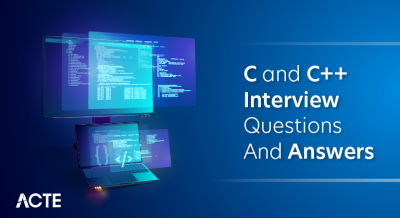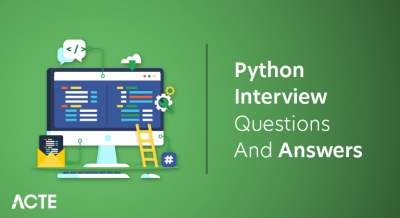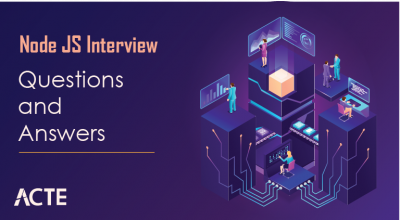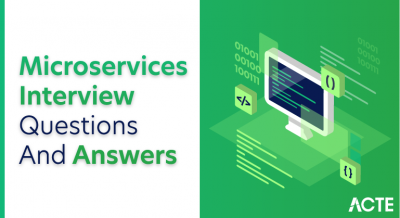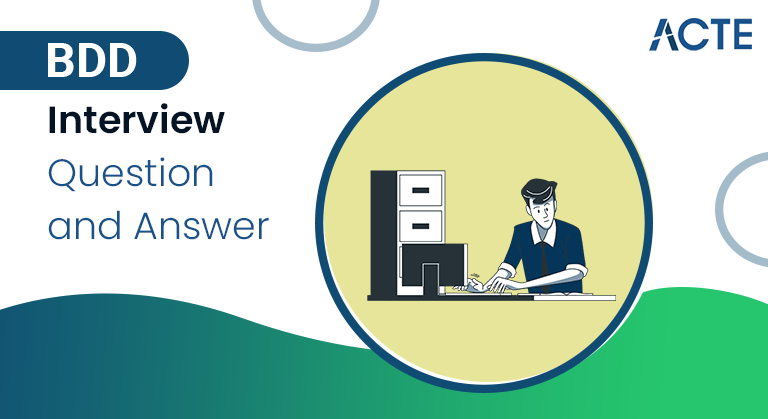
At ACTE, the focus on Behavioral Driven Development (BDD) interview questions reflects a commitment to providing comprehensive and reliable resources for employers and potential candidates. The platform ensures access to many BDD interview questions and answers spanning various fields, promising lucrative employment opportunities in a dynamic and creative work environment. Job seekers benefit from the clarity of job listings and the platform’s commitment to staying abreast of the ever-evolving requirements of employers and market trends. ACTE strives to simplify the job search process, offering a one-stop solution for individuals seeking rewarding positions that align with the principles of Behavioral Driven Development.
1. What is BDD?
Ans:
BDD (Behavior Driven Development) is the software development methodology that emphasizes defining expected behavior of a software using human-readable language, facilitating collaboration between the technical & non-technical stakeholders. While TDD (Test Driven Development) focuses on writing a tests before code & is more developer-centric, BDD extends the TDD by concentrating on software’s behavior & fostering communication among the developers, testers & business analysts.
2. What are key benefits of using BDD?
Ans:
The key benefits of using the BDD include the improved communication & collaboration among team members, shared the understanding of software requirements, clearer & more maintainable documentation, faster feedback & higher-quality software with the fewer defects.
3. Describe BDD workflow & how it differs from traditional development workflows.
Ans:
The BDD workflow differs from a traditional development workflows by placing collaboration & communication at its core. Stakeholders jointly define a software behavior through the features & scenarios using the common human-readable language. The process typically includes following steps: writing feature files with the scenarios, implementing step definitions for those scenarios, running tests to validate implementation, & iterating as needed to refine the behavior.
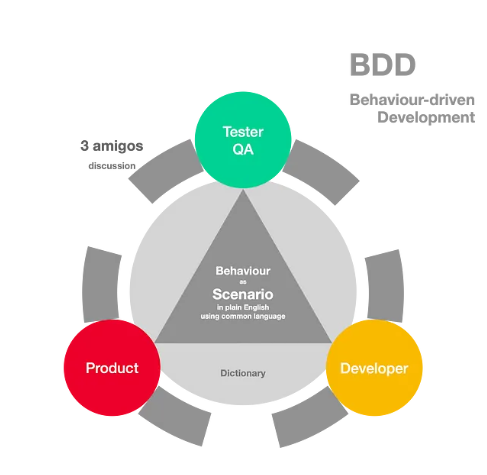
4. How does BDD help with collaboration & communication between developers, testers, & business stakeholders?
Ans:
- BDD helps with the collaboration & communication between developers, testers & business stakeholders by establishing common language to describe software behavior, bridging gap between the technical & non-technical team members.
- This shared understanding ensures that everyone is on a same page regarding the software’s requirements, leading to the fewer misunderstandings & more efficient development.
5. Difference between feature & scenario in BDD.
Ans:
- In BDD, feature is the high-level description of a functionality or behavior of a software being developed. It describes a business value & purpose of the functionality. A scenario, on other hand, is a specific example that demonstrates a behavior of a feature in the particular situation or context.
- It outlines sequence of steps, expressed in a Given-When-Then format, that describe expected behavior of the feature. While the feature provides a broad overview of what software should do, scenarios provide a concrete examples of how the software should behave in the specific situations.
6. How do write good, effective scenarios in BDD?
Ans:
To write a good, effective scenarios in BDD, it’s crucial to keep them clear, concise, and focused on the specific behaviors or outcomes. Begin by collaborating with stakeholders to identify the key user requirements and use Gherkin language to create scenarios in a Given-When-Then format Ensure that every scenario represents the single user action or coherent sequence of actions with the well-defined preconditions, actions, and expected results. Avoid technical jargon and write scenarios in the natural language that is easy to understand for both the technical and non-technical team members. Finally, strive for consistency in naming conventions and structure, and ensure scenarios are the independent and maintainable, making it simpler to identify and address any issues that may arise during the development.
7. What are common mistakes that teams make implementing BDD?
Ans:
Some common mistakes that teams make when implementing the BDD include insufficient collaboration between the technical and non-technical stakeholders, leading to miscommunication and misaligned expectations; overemphasis on the test automation, causing teams to overlook the importance of behavior specification; writing vague, complex, or interdependent scenarios that hinder test maintenance and understanding; neglecting to the keep “Living Documentation” up-to-date, resulting in outdated or the inconsistent documentation; and failing to invest in the proper training and tooling, which can hamper the team’s ability to apply the BDD principles and practices effectively. Addressing these pitfalls is crucial to sbe uccessfully adopting BDD and reaping its full benefits.
8. How do determine which scenarios to automate & which ones to test manually?
Ans:
When determining which scenarios to be automate & which ones to test manually, it is important to be consider factors such as the frequency of use, the complexity of scenario, & the potential impact of failure. Scenarios that are used frequently, are complex, & have high potential impact of failure are good candidates for automation, while simpler scenarios with the lower impact of failure may be more appropriate for a manual testing.
9. What tools are commonly used for implementing BDD?
Ans:
Common tools for the implementing BDD include the Cucumber, SpecFlow, & Behat. These tools provide the common language for describing scenarios & can help to automate a testing process. However, they can also be complex to set up & maintain, & may require the significant investment in training & infrastructure.
10. How do measure success of BDD implementation?
Ans:
The success of the BDD implementation can be measured in the number of ways, including the improved collaboration between team members, faster feedback loops, & reduction in defects & rework. It is also important to track the metrics such as number of automated tests, percentage of code covered by tests, & the time required to be execute tests.
11. What are key roles in BDD team, & what are responsibilities?
Ans:
Key roles in the BDD team include product owners, business analysts, developers, testers, & automation engineers. Product owners are the responsible for defining the project requirements, while business analysts work to ensure that requirements are clear & unambiguous. Developers are the responsible for implementing required functionality, while testers & automation engineers are responsible for an ensuring that software is tested thoroughly.
12. How BDD scenarios are aligned with project’s business objectives?
Ans:
To ensure that BDD scenarios are aligned with project’s business objectives, it is important to involve the stakeholders & domain experts early on in process. Scenarios should be based on the realistic examples & should be written in the way that is easy to understand & maintain over time.
13. How do handle changes to requirements during development process when using BDD?
Ans:
When handling the changes to requirements during development process, it is important to ensure that all the team members are aware of the changes & that scenarios are updated accordingly.
14. How does BDD fit into Agile development methodologies?
Ans:
- BDD is the key component of Agile development methodologies, as it helps to ensure that a software is developed in the collaborative & iterative manner. By focusing on behavior rather than the implementation details, BDD helps to ensure that software is developed in the way that meets the needs of stakeholders & users.
- BDD scenarios are the often used as acceptance criteria, providing the common language for all team members to understand what needs to be delivered. BDD also helps to ensure that testing is integral part of development process, with tests being written & executed early & often to provide a fast feedback & reduce the risk of defects.
15. Describe three core elements of BDD: Given, When, & Then?
Ans:
- The three core elements of the BDD are Given, When, & Then. Given represents initial state of the system or application, including the any preconditions or setup required for a scenario. When represents action or event that triggers a behavior being tested.
- Finally, Then represents expected outcome or result of behavior being tested. Together, these three elements provide the clear & concise way to describe the behavior of system or application, helping to ensure that all the team members have a common understanding of what needs to be delivered.
16. How do write effective Given, When, & Then statements?
Ans:
To write effective Given, When, & Then statements, it is a important to focus on behavior of the system or application rather than implementation details. Statements should be a clear & concise, using specific examples to the illustrate the behavior being tested. It is also important to ensure that statements are written from perspective of the user, rather than system.
17. How do handle edge cases in BDD scenarios?
Ans:
Handling edge cases in the BDD scenarios involves identifying and addressing the potential exceptional situations that may arise while using the software. Begin by collaborating with the stakeholders and development teams to identify and define a potential edge cases. Then, write clear and focused Gherkin scenarios for every edge case using the Given-When-Then format, clearly outlining preconditions, actions, and expected results. By explicitly addressing edge cases in the BDD scenarios, ensure that the system behaves as expected even in the unusual or uncommon situations, resulting in the more robust and reliable application.
18. Explain “living documentation” in BDD.
Ans:
In BDD, concept of “living documentation” refers to dynamically updated, easily accessible, and human-readable documentation generated from executable specifications written in the Gherkin language. As Gherkin scenarios are written in the natural language format, they serve as common ground for both technical and non-technical stakeholders to understand application’s behavior and requirements.
19. How do prioritize which scenarios to implement first?
Ans:
When prioritizing scenarios, it is important to the consider factors such as business value, risk, & complexity. Scenarios that deliver most business value or have the highest risk should be a prioritized first, while simpler scenarios can be addressed later in development process.
20. How do manage dependencies between scenarios in BDD?
Ans:
To manage dependencies between the scenarios in BDD, it is important to identify any shared functionality or the resources & ensure that these are tested thoroughly. This may involve the breaking larger scenarios down into the smaller, more manageable pieces, or developing the framework to manage shared resources.
21. How would use BDD to test complex feature?
Ans:
When testing the complex feature using BDD, it is important to break feature down into the smaller, more manageable pieces, & write scenarios to test each piece of functionality. These scenarios can then be combined to form the larger, end-to-end tests that cover an entire feature.
22. How can avoid creating overly complex scenarios in BDD?
Ans:
To avoid creating the overly complex scenarios in BDD, it is important to focus on a behavior of the system or application, rather than implementation details. Scenarios should be written in the clear & concise manner, using a specific examples to illustrate the behavior being tested.
23. Difference between “happy path” & “alternative path” in BDD scenarios.
Ans:
| Aspect | Happy Path | Alternative Path | |
| Definition | The most common and expected flow through a scenario | An alternative or exceptional flow in a scenario | |
| Focus | Represents the successful execution of the main functionality | Addresses potential deviations or exceptions | |
| Scenario Outcome | Successful completion of the primary task | Handling deviations, errors, or exceptional cases | |
| Testing Priority | Typically, the first focus of testing to ensure core functionality works | Follows the happy path and is often tested after ensuring the happy path is functioning correctly | |
| Purpose | Ensures the fundamental functionality is working as intended | Validates the system’s behavior under diverse conditions and potential issues |
24. How do ensure that BDD scenarios are maintainable & easy to update?
Ans:
To ensure that BDD scenarios are the maintainable & easy to update, it is important to involve all the members of the team in the process & to use a common language to the describe scenarios. Regular reviews & feedback sessions can also help to identify and address any issues early on.
25. Describe BDD testing pyramid.
Ans:
The BDD testing pyramid represents different types of tests that should be included in the BDD testing strategy. At the base of pyramid are unit tests, which are used to test individual pieces of code. In middle of the pyramid are integration tests, which test how different pieces of a code work together.
At the top of pyramid are end-to-end tests, which test entire system or application. The pyramid emphasizes importance of including the mix of different types of tests to ensure thorough testing while also maintaining the fast feedback loop.
26. How do BDD scenarios are readable & understandable by all team members?
Ans:
To ensure that BDD scenarios are the readable & understandable by all team members, it is important to use the common language & to involve all members of the team in scenario writing process. Scenarios should be written in the clear & concise manner, using specific examples to illustrate behavior being tested.
27. Explain BDD used to improve user acceptance testing.
Ans:
BDD can be used to improve the user acceptance testing by ensuring that scenarios are written from a perspective of the user & are aligned with project’s business objectives. By involving the stakeholders & domain experts in scenario writing process, BDD helps to ensure that software meets the needs of the user & is delivered in the collaborative & iterative manner.
28. How do handle data-driven testing in BDD scenarios?
Ans:
To handle data-driven testing in the BDD scenarios, can use Scenario Outlines and Examples tables to create a reusable, parameterized tests that cover multiple input combinations without duplicating code. In the Scenario Outline, define placeholders using angle brackets (<>) within the Given-When-Then steps, which represent variable data points.
29. Describe how BDD can be used for API testing.
Ans:
BDD can be used for the API testing by writing scenarios that describe expected behavior of the API. These scenarios can include the calls to the API & expected responses, helping to ensure that API meets the needs of the user and is tested thoroughly.
30. How do handle negative testing in BDD scenarios?
Ans:
- To handle the negative testing in BDD scenarios, create Gherkin scenarios that focus on the testing the application’s behavior when it encounters the invalid inputs or unexpected user actions.
- These scenarios should outline preconditions, actions, and expected results using Given-When-Then format, while specifically targeting situations where the system might fail or produce errors. By incorporating the negative testing in BDD scenarios, can ensure that the application gracefully handles the improper usage, invalid data, or unexpected situations, thus enhancing its overall robustness and reliability.
31. How do handle asynchronous processes in BDD scenarios?
Ans:
Handling asynchronous processes in the BDD scenarios involves the explicitly defining steps to account for inherent delays or waiting times associated with the such processes. In the Given-When-Then structure, can include steps to wait for a specific conditions or events to occur, such as completion of a background task or appearance of the particular UI element.
32. How do handle testing across multiple platforms in BDD?
Ans:
Handling testing across the multiple platforms in BDD involves leveraging flexibility of BDD frameworks & tools to accommodate the varying environments, devices, & configurations. Start by ensuring that Gherkin scenarios are the platform-agnostic & focus on describing application’s behavior rather than platform-specific details.
Utilize abstraction layers to a separate platform-specific implementation details from core logic of your test scenarios. Depending on BDD tool or framework, can leverage built-in features, like tags or profiles, to run specific sets of tests for every platform. Finally, integrate the BDD test suite with continuous integration & continuous deployment (CI/CD) pipelines to the automate the execution of tests across the different platforms, ensuring consistent behavior & quality across all the supported environments.
33. How do handle testing across multiple browsers in BDD?
Ans:
Handling testing across multiple browsers in the BDD involves using the combination of flexible BDD frameworks, browser automation tools & appropriate test configurations. Start by ensuring Gherkin scenarios are browser-agnostic, focusing on application’s behavior rather than a browser-specific details. Utilize a browser automation tool, like Selenium WebDriver, to interact with browsers & run the BDD tests.
34. How BDD can be used for accessibility testing?
Ans:
BDD can be used for the accessibility testing by incorporating the accessibility requirements into Gherkin scenarios and leveraging specialized testing tools. Collaborate with the stakeholders to identify accessibility requirements based on the standards such as WCAG or Section 508, and write Gherkin scenarios that cover a key accessibility aspects.
35. How BDD can used for performance testing?
Ans:
- BDD can be used for a performance testing by incorporating performance requirements into the Gherkin scenarios and leveraging specialized testing tools. Identify the performance requirements and expectations, and write Gherkin scenarios to be describe the specific performance behaviors and features.
- Integrate the BDD test suite with the performance testing tools or libraries, like JMeter, Gatling, or LoadRunner, to simulate various load and concurrency scenarios. Use a custom step definitions or hooks to assess and report application’s performance during test execution.
36. How do handle testing in distributed systems using BDD?
Ans:
In distributed systems, Behavior Driven Development (BDD) is employed by creating the user-focused scenarios that define expected behavior of the system components, thus enabling an effective communication & collaboration among the team members. By utilizing BDD tools are Cucumber, SpecFlow, or Behave, these scenarios are the translated into automated test cases, which are executed against individual components & their interactions in a distributed system.
37. How do handle testing microservices using BDD?
Ans:
- When testing microservices using the Behavior Driven Development (BDD), create user-focused scenarios that describe expected behavior of each microservice, promoting the shared understanding among team members. By leveraging the BDD tools like Cucumber, SpecFlow, or Behave, can transform these scenarios into the automated test cases, which are executed against the individual microservices, including APIs & interactions with the other services.
- This approach ensures that every microservice behaves as expected & that interactions within system are seamless, allowing for early detection of the potential issues & facilitating continuous delivery of a reliable & maintainable microservices.
38. Describe how BDD can be used for security testing?
Ans:
- Behavior Driven Development (BDD) can be used for a security testing by defining scenarios that outline potential security threats and vulnerabilities, focusing on user behavior and system responses. By employing BDD tools like Cucumber, SpecFlow, or Behave, these scenarios are translated into the automated test cases, which are executed against application to validate its security posture.
- This approach helps teams to prioritize security from onset of development, encouraging collaboration between the security experts and developers, and allowing early detection and mitigation of a security risks. BDD thus contributes to the building secure applications by fostering proactive security mindset and validating application’s ability to handle the threats effectively.
39. How do handle testing for mobile applications using BDD?
Ans:
For mobile applications, Behavior Driven Development (BDD) is employed by a crafting user-focused scenarios that describe expected functionality and behavior of app, fostering clear communication among the team members. Utilizing BDD tools are Cucumber or SpecFlow, these scenarios are translated into the automated test cases.
40. How do handle testing for web applications using BDD?
Ans:
To handle the testing for web applications using BDD, it is important to write a scenarios that test the behavior of application on different browsers & platforms. These scenarios can include the tests for different user interactions & features, helping to ensure that application meets the needs of user & is tested thoroughly.
41. How do ensure BDD scenarios are easily maintainable & scalable?
Ans:
To ensure that BDD scenarios are the easily maintainable & scalable, it is important to use the common language & to involve all members of team in the scenario writing process.. Additionally, using frameworks and tools that support the BDD can help to ensure that scenarios are easily maintainable & scalable over time.
42. Explain how BDD can used for load testing.
Ans:
BDD can be used for a load testing by writing scenarios that test behavior of the software under the different loads or conditions. These scenarios can help to identify the any performance issues early on & ensure that software meets the needs of the user.
43. Describe BDD can be used for end-to-end testing.
Ans:
Behavior Driven Development (BDD) can be utilized for the end-to-end testing by defining user-centric scenarios that encompass entire application workflow, from the user interface to the backend systems and integrations. By using the BDD tools like Cucumber, SpecFlow, or Behave, these scenarios are translated into the automated test cases.
44. How do handle testing for different user roles in BDD scenarios?
Ans:
- Can begin by creating a separate scenarios or scenario outlines for each user role, detailing expected behavior and interactions specific to that role. Each scenario should capture unique context, actions, and outcomes for a given user role, focusing on their permissions and restrictions within the application.
- By employing BDD tools areCucumber, SpecFlow, or Behave, these scenarios are transformed into the automated test cases. When executing test cases, ensure proper setup of a test data and user accounts representing different roles, validating that application behaves correctly and securely for each user role, and confirming that a role-specific functionality and access the controls are implemented as intended.
45. How do handle testing for different user interfaces in BDD scenarios?
Ans:
To handle testing for a different user interfaces in BDD scenarios, it is important to a write scenarios that test the behavior of a software on different devices & platforms. These scenarios can include the tests for a different user interactions & features, helping to ensure that software meets the needs of user & is tested thoroughly.
46. Explain BDD can be used for integration testing.
Ans:
BDD can be used for the integration testing by writing scenarios that test behavior of different components or modules of system, as well as the interactions between them. These scenarios can help to identify the any integration issues early on & ensure that system meets the needs of user & is tested thoroughly.
47. How do handle testing for different environments using BDD scenarios?
Ans:
To handle testing for a different environments using BDD scenarios, it is important to write the scenarios that can be easily adapted to various environments. These scenarios can be run in the different environments to ensure that software meets the needs of user & is tested thoroughly.
48. Explain BDD can be used for acceptance testing.
Ans:
BDD can be used for the acceptance testing by ensuring that scenarios are written from a perspective of the user & are aligned with project’s business objectives. By involving the stakeholders & domain experts in scenario writing process, BDD helps to ensure that software meets the needs of the user & is delivered in the collaborative & iterative manner.
49. How do handle testing for third-party integrations in BDD scenarios?
Ans:
To handle testing for a third-party integrations in BDD scenarios, it is important to write the scenarios that test the behavior of integration, including any inputs or outputs. These scenarios can help to ensure that integration meets the needs of user & is tested thoroughly.
50. How BDD can be used for localization testing?
Ans:
BDD can be used for localization testing by writing scenarios that test behavior of the software in the different languages or locales. These scenarios can help to ensure that software meets the needs of users in the different regions & is tested thoroughly.
51. How do ensure BDD scenarios are reusable & modular?
Ans:
To ensure that BDD scenarios are the reusable & modular, it is important to break scenarios down into the smaller, more manageable pieces, & to use a common language & framework to describe the scenarios.
52. Describe how BDD can be used for continuous testing.
Ans:
BDD can be used for a continuous testing by incorporating scenarios into continuous integration & delivery pipeline. This helps to ensure that software is tested thoroughly and that any potential issues are the identified & addressed early on.
53. How do ensure that BDD scenarios are aligned with user stories & business requirements?
Ans:
To ensure that BDD scenarios are the aligned with user stories & business requirements, it is important to involve the stakeholders & domain experts in the scenario writing process. Scenarios should be written from perspective of the user & should be aligned with project’s business objectives.
54. Explain the role of domain experts in BDD.
Ans:
Domain experts play the important role in BDD by providing expertise & guidance on behavior of the system or application. By involving domain experts in a scenario writing process, BDD helps to ensure that software meets the needs of the user & is delivered in the collaborative & iterative manner.
55. How do handle testing for complex business logic in BDD scenarios?
Ans:
To handle testing for complex business logic in BDD scenarios, it is important to break scenarios down into the smaller, more manageable pieces, & to use tables to represent a different data inputs & expected outcomes. These scenarios can help to ensure that business logic is tested thoroughly & that software meets the needs of user.
56. How do ensure that BDD scenarios are comprehensive and cover all possible use cases?
Ans:
To ensure that BDD scenarios are the comprehensive & cover all possible use cases, it is important to involve the all members of the team in a scenario writing process, including the domain experts & stakeholders.
57. How BDD can used for exploratory testing?
Ans:
While Behavior Driven Development (BDD) primarily focuses on the predefined scenarios, it can still indirectly support exploratory testing by providing a foundation for understanding expected behavior of the application. BDD scenarios help establish the shared knowledge base among team members, which can be used as starting point for exploratory testing sessions.testers can use creativity, intuition, and domain knowledge to identify potential edge cases or unexpected behaviors that may not have been covered by BDD scenarios. By combining structured approach of BDD with flexibility of exploratory testing, teams can achieve the more comprehensive assessment of application’s quality, functionality, and resilience to the various user inputs and actions.
58. How do handle testing for edge cases and negative scenarios in BDD?
Ans:
To handle testing for a edge cases and negative scenarios in BDD, create scenarios that specifically target these situations, incorporating the uncommon inputs, unexpected user actions, or invalid data. By using the BDD tools like Cucumber, SpecFlow, or Behave, these scenarios are translated into the automated test cases, which are executed against the application.
59. How BDD can used for usability testing?
Ans:
Behavior Driven Development (BDD) can support the usability testing by focusing on user-centric scenarios that outline expected user experience, interactions, and outcomes within application. BDD tools like a Cucumber, SpecFlow, or Behave transform these scenarios into an automated test cases, which, when combined with the manual or automated UI testing frameworks, can validate application’s usability aspects.
60. How do handle testing for different device types?
Ans:
To handle testing for a different device types & screen sizes using BDD scenarios, it is the important to write scenarios that test behavior of the software on each device & screen size. These scenarios can be run on every device & screen size to ensure that software meets the needs of user & is tested thoroughly.
61. How do ensure BDD scenarios are maintainable and don’t become obsolete over time?
Ans:
To ensure that BDD scenarios are the maintainable & don’t become obsolete over time, it is important to use the common language & framework to describe scenarios, & to regularly review & update the scenarios as software evolves. Additionally, using the tools & frameworks that support BDD can help to ensure that scenarios are easily maintainable and don’t become the obsolete over time.
62. How BDD can used for continuous delivery and deployment?
Ans:
Through the automated test cases derived from user-centric scenarios, Behavior Driven Development (BDD) can be used to facilitate the continuous delivery and deployment by ensuring application’s behaviour aligns with the user expectations. BDD encourages collaboration among the developers, testers, and other stakeholders, promoting shared understanding of requirements and resulting in the more maintainable code and shorter development cycles. BDD test cases are updated and integrated into continuous integration and continuous delivery (CI/CD) pipeline as application evolves.
63. How do handle testing for security vulnerabilities in BDD scenarios?
Ans:
To handle testing for a security vulnerabilities in BDD scenarios, it is important to write the scenarios that test the security features of software, such as authentication & authorization, as well as scenarios that test for a different types of attacks. These scenarios can help to ensure that software is secure & meets the needs of user.
64. How BDD can used for testing machine learning models?
Ans:
BDD can be used for a testing machine learning models by writing scenarios that test model’s behavior under the different inputs & conditions. These scenarios can help to ensure that model meets the needs of user & is tested thoroughly.
65. How does ensure BDD scenarios are easily understandable by non-technical stakeholders?
Ans:
- It is important to use the common language so that non-technical stakeholders easily understand scenario writing process. Scenarios should be written in a clear & concise manner, using specific examples to the illustrate the behavior being tested.
- It is critical to use the language that is accessible & free of technical jargon to ensure BDD scenarios are easily understandable by a non-technical stakeholders. Gherkin is specifically designed for this purpose, with the keywords & syntax that are simple to read & understand. Involving a non-technical stakeholders in scenario-writing process also helps to ensure that scenarios accurately reflect understanding of a system and its behaviour.
66.What is Cucumber?
Ans:
Cucumber is the open-source BDD tool that allows developers & testers to write & execute automated tests based on the business requirements. It enables the stakeholders to collaborate & define the common language and set of specifications that can be easily understood by all the team members.
67. What is feature file in Cucumber?
Ans:
A feature file in cucumber isthe text file written in Gherkin that captures expected behavior of specific feature or the functionality of an application. It describes user-centric scenarios in the structured, human-readable format, encouraging stakeholder collaboration and shared understanding. Cucumber reads a feature file to generate automated test cases which are then run to the validate the application’s behavior.
68. What is Gherkin language?
Ans:
The Gherkin language is the domain-specific language used in context of Behavior-Driven Development to create structured, human-readable test cases (BDD). By defining a software behavior using simple, natural language syntax, Gherkin enables the developers and non-technical stakeholders to collaborate effectively. To outline the various components of test cases, language employs keywords such as Feature, Scenario, Given, When, Then, and And, making it simple to understand, write, and maintain the acceptance criteria and executable specifications for a software projects.
69. What is scenario outline in Cucumber?
Ans:
In Cucumber, Scenario Outline is the template for creating multiple scenarios with the varying input values and expected outcomes. It enables the developers to define the multiple test cases efficiently by specifying single generic scenario structure and supplying the different data sets in an Examples table. Each row in Examples table represents separate test case derived from a Scenario Outline, allowing for a more concise and data-driven testing. This approach reduces the code duplication, simplifies test suite maintenance, and improves the feature file readability in the Cucumber project.
70. What ishook in Cucumber?
Ans:
A hook in Cucumber is the mechanism that allows the developers to execute specific code snippets at a different points during test execution lifecycle. Hooks can be used for a tasks such as setting up test data, managing browser sessions, or cleaning up the resources after tests. Common hooks include the Before, After, BeforeStep, and AfterStep, which are executed before or after scenario or individual steps, respectively. By using the hooks, developers can enhance the test code organization, modularity, and reusability, making test suite more maintainable and efficient.
71. What are benefits of using Cucumber for BDD?
Ans:
Using Cucumber for a BDD provides the several benefits, including increased the collaboration among team members, improved test coverage, better documentation of a software behavior, and faster feedback on changes made to a software.
72. What are limitations of using Cucumber for BDD?
Ans:
Some of the limitations of using the Cucumber for BDD include potential for creating complex & difficult-to-maintain test suites, need for strong technical skills to write and execute automated tests, and the possibility of creating false confidence in a software if the tests are not well-designed or maintained.
73. Explain structure of Cucumber feature file?
Ans:
A Cucumber feature file typically includes the Feature, a Background (optional), multiple Scenarios, & Scenario Outlines. The Feature provides the high-level description of functionality being tested, Background specifies any preconditions or steps that are common across all the scenarios, & the Scenarios & Scenario Outlines define different use cases & test cases.
74. What is Cucumber runner class?
Ans:
A Cucumber runner class is the Java class that contains the necessary annotations and configuration settings to execute Cucumber tests. It is used to specify a location of feature files and step definition classes, as well as any plugins or options for a test execution.
75. Explain difference between BDD & TDD.
Ans:
BDD (Behavior Driven Development) focuses on the defining expected behavior of a software using human-readable language & collaboration between stakeholders, while the TDD (Test Driven Development) emphasizes writing the tests before writing the actual code. BDD is the extension of TDD that aims to improve the communication & collaboration among team members.
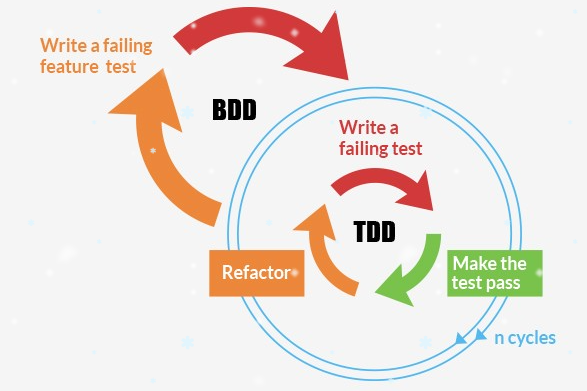
76. What is Test-Driven Development (TDD)?
Ans:
Test-Driven Development is the Agile software development methodology that emphasizes the writing tests before writing the actual code. It follows the cycle of writing a failing test, writing a code to make the test pass, and then refactoring the code to improve structure.
77. How does BDD improve upon TDD?
Ans:
BDD improves upon the TDD by emphasizing collaboration between the developers, testers, and business analysts. It uses the human-readable language (like Gherkin) to define behavior of the software, making it simpler for all the stakeholders to understand and contribute to development process.
78. What are benefits of using TDD?
Ans:
- Improved the code quality
- Faster feedback on the changes
- Simpler debugging & maintenance
- Reduced the development time
- Better collaboration among team members
79. What are the benefits of using BDD?
Ans:
- Enhanced the communication & collaboration among stakeholders
- Clearer understanding of software requirements
- Improved a test coverage
- Better documentation of a software behavior
- Faster feedback on changes
80. What is tester in TDD & BDD?
Ans:
In TDD, a tester may work closely with the developers to help design and review tests, & provide feedback on the test coverage & code quality. In BDD, a tester often takes on more active role in defining a software behavior, collaborating with the developers & business analysts to write & review feature files & test scenarios.
81. What tools can used for TDD & BDD?
Ans:
For TDD, popular tools include the JUnit, TestNG, xUnit, & NUnit, among others. For BDD, popular tools include the Cucumber, SpecFlow, Behave, & JBehave, which integrate with the various testing frameworks.
82. What are challenges in implementing TDD & BDD?
Ans:
- Resistance to change or adoption of the new methodologies
- Insufficient knowledge or training in the TDD/BDD practices
- Overemphasis on testing at expense of other development tasks
- Poorly designed or maintained tests leading to false confidence in a software
83. How do TDD & BDD fit into Agile software development process?
Ans:
TDD (Test Driven Development) & BDD (Behavior Driven Development) complement Agile software development process by emphasizing iterative, incremental development and collaboration among team members. TDD ensures the code is testable of high quality by writing tests before code, while BDD enhances communication and understanding of software behavior using the human-readable language, bridging gap between technical and non-technical stakeholders. Both the approaches facilitate quick feedback loops, foster collaboration, and promote shared understanding of a software requirements, aligning with the Agile principles & practices.
84. What are main files required to run Cucumber test scenario?
Ans:
The Two main files used to run the Cucumber test scenario are,
- Step Definition
- Features
85. What is meant by feature file?
Ans:
A feature file offers the high-level description of Application Under Test (AUT). It consists of following components:
- Feature: It defines implementation of a current test script.
- Scenario: It is expected outcome and steps for specific test case.
- Scenario outline: It can be executed for the multiple sets of data.
- Given: It defines a context of text to be implemented.
- When: It specifies the test action that has to perform.
- Then: The expected outcome of the test can be represented by “Then.”
86. Mention differences between BDD and TDD.
Ans:
| BDD | TDD |
| BDD is the Behavior centered development process. | TDD is a Test centered development process. |
| These tests are the represented in readable format using BDD steps. | These tests are the represented using programming languages are JAVA, Ruby, etc., |
87. Give an example of behavior-driven test in plain text.
Ans:
The example of the behavior-driven test in plain text is:
- Feature: Visit ABC page on xyz.com
- Given: I am on xyz.com
- Scenario: Visit xyz.com
- When: click on ABC page
- Then: I should see ABC page
88. What is Background keyword in feature file?
Ans:
The Background keyword in the feature file serves to define the set of common steps that should be executed before each scenario within same feature. This allows for reduction of duplicated steps across the multiple scenarios, improving readability and maintainability of a feature file. By using Background keyword, developers can create a more modular and streamlined test cases, focusing on unique aspects of each scenario while sharing repetitive setup steps in the centralized manner.
89. Why use Cucumber with Selenium?
Ans:
Cucumber and Selenium are the two well-known technologies. More companies are using the Selenium for functional testing. These organizations using Selenium want to integrate the Selenium with Cucumber as it helps to read and understand application flow.
90. What software need to run Cucumber Web Test case?
Ans:
The following are software required to run the Cucumber Web Test case:
- Cucumber
- Ruby and its Development Kit
- IDE like ActiveState
- Watir (To simulate browser)
- RSpec and Ansicon


